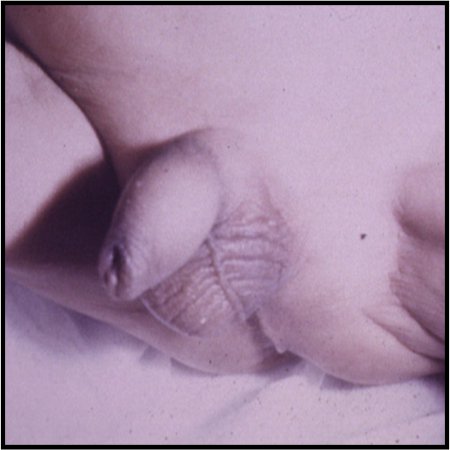Characteristic history and exam findings are sufficient to diagnose the condition. Imaging and/or laboratory evaluation are not indicated in the initial evaluation of cryptorchidism.[53]American Academy of Pediatrics Section on Urology. Five things physicians and patients should question. Choosing Wisely, an initiative of the ABIM Foundation. 2022 [internet publication].
https://web.archive.org/web/20230325231547/https://www.choosingwisely.org/societies/aap-pediatric-urology
[54]American Urological Association. Fifteen things physicians and patients should question. Choosing Wisely, an initiative of the ABIM Foundation. 2022 [internet publication].
https://web.archive.org/web/20230209033431/https://www.choosingwisely.org/societies/american-urological-association
History
Cryptorchidism is generally noted on routine physical exam, but the patient and/or parents should be questioned regarding history of palpable testes on previous exams, presence of testes at times when the patient is relaxed such as in the bathtub (may suggest excessive cremasteric reflex or retractile testes), and previous inguinal surgery (iatrogenic cryptorchidism). A family history may be present.
Physical exam
Exam should take place in a supine position. The patient should be warm and as relaxed as possible. Presence or absence of the testes, and position and size of each testis should be noted, as well as the presence of an asymmetric or hypoplastic scrotum and any surgical scars in the inguinal or scrotal region.[Figure caption and citation for the preceding image starts]: Photograph showing left undescended testicleFrom the personal collection of Professor Duncan T. Wilcox [Citation ends].
A retractile testis is a testis that is located in a suprascrotal position but can be manipulated down without pain into the scrotum and remains there after traction is released. This is considered a normal variant in position, and these patients generally do not undergo treatment, but should be followed for acquired cryptorchidism and/or reduced testicular volume, which could prompt treatment.
A palpable cryptorchid testis is unable to be pulled into the scrotum or immediately returns to a higher position after being manipulated into the scrotum.
A nonpalpable testis is unable to be located/palpated in the scrotum, inguinal canal, or femoral or perineal regions despite thorough physical exam. Some physicians place a little lubrication on the patient's skin as that can help in identifying an intracanalicular testis.
Cryptorchidism may also present as an ascending event in patients with previously documented normal testis position in the scrotum. The testis is later noted to have ascended into the high portion of the scrotum or the inguinal canal.
Finally, the physical exam should include:
Inspection and documentation of location of the urethral meatus (specifically looking for hypospadias)
Assessment for penile length less than 2 standard deviations below normal for age (micropenis)
Exam of secondary sex characteristics/pubertal signs for patients presenting with cryptorchidism at an older age.
Imaging and surgical exploration
Current evidence does not support routine imaging for cryptorchidism.[53]American Academy of Pediatrics Section on Urology. Five things physicians and patients should question. Choosing Wisely, an initiative of the ABIM Foundation. 2022 [internet publication].
https://web.archive.org/web/20230325231547/https://www.choosingwisely.org/societies/aap-pediatric-urology
[54]American Urological Association. Fifteen things physicians and patients should question. Choosing Wisely, an initiative of the ABIM Foundation. 2022 [internet publication].
https://web.archive.org/web/20230209033431/https://www.choosingwisely.org/societies/american-urological-association
[55]Kolon TF, Herndon CD, Baker LA, et al. Evaluation and treatment of cryptorchidism: AUA guideline. J Urol. 2014 Aug;192(2):337-45.
https://www.auanet.org/guidelines/cryptorchidism-(2014)
http://www.ncbi.nlm.nih.gov/pubmed/24857650?tool=bestpractice.com
[56]Cho A, Thomas J, Perera R, et al. Undescended testis. BMJ. 2019 Mar 25;364:l926.
http://www.ncbi.nlm.nih.gov/pubmed/30910854?tool=bestpractice.com
[57]European Association of Urology. Guidelines on paediatric urology. 2022 [internet publication].
https://d56bochluxqnz.cloudfront.net/documents/full-guideline/EAU-Guidelines-on-Paediatric-Urology-2022.pdf
For infants with bilateral cryptorchidism referred for evaluation of a difference in sex development (DSD), ultrasound is recommended first-line to delineate internal genitalia and assess renal anatomy and drainage.[29]Ahmed SF, Achermann J, Alderson J, et al. Society for Endocrinology UK Guidance on the initial evaluation of a suspected difference or disorder of sex development (Revised 2021). Clin Endocrinol (Oxf). 2021 Dec;95(6):818-40.
https://onlinelibrary.wiley.com/doi/10.1111/cen.14528
http://www.ncbi.nlm.nih.gov/pubmed/34031907?tool=bestpractice.com
Surgical exploration (typically laparoscopic) is recommended for all nonpalpable unilateral testicles, and many bilateral cryptorchid patients.[58]Tasian GE, Copp HL. Diagnostic performance of ultrasound in nonpalpable cryptorchidism: a systematic review and meta-analysis. Pediatrics. 2011 Jan;127(1):119-28.
http://www.ncbi.nlm.nih.gov/pubmed/21149435?tool=bestpractice.com
Human chorionic gonadotropin (hCG) stimulation test
This is rarely required.
Literature demonstrates that a phenotypic 46 XY male with bilateral nonpalpable testes has anorchia if Mullerian inhibiting substance (MIS) and inhibin B are undetectable and follicle-stimulating hormone is elevated, making the hCG stimulation test unnecessary in most cases.[55]Kolon TF, Herndon CD, Baker LA, et al. Evaluation and treatment of cryptorchidism: AUA guideline. J Urol. 2014 Aug;192(2):337-45.
https://www.auanet.org/guidelines/cryptorchidism-(2014)
http://www.ncbi.nlm.nih.gov/pubmed/24857650?tool=bestpractice.com
[59]Teo AQ, Khan AR, Williams MP, et al. Is surgical exploration necessary in bilateral anorchia? J Pediatr Urol. 2013 Feb;9(1):e78-81.
https://www.jpurol.com/article/S1477-5131(12)00229-X/fulltext
http://www.ncbi.nlm.nih.gov/pubmed/23079081?tool=bestpractice.com
[60]Brauner R, Neve M, Allali S, et al. Clinical, biological and genetic analysis of anorchia in 26 boys. PLoS One. 2011;6(8):e23292.
https://journals.plos.org/plosone/article?id=10.1371/journal.pone.0023292
http://www.ncbi.nlm.nih.gov/pubmed/21853106?tool=bestpractice.com
[61]Wei Y, Wang Y, Tang X, et al. Efficacy and safety of human chorionic gonadotropin for treatment of cryptorchidism: a meta-analysis of randomised controlled trials. J Paediatr Child Health. 2018 Apr 14;54(8):900-6.
http://www.ncbi.nlm.nih.gov/pubmed/29655188?tool=bestpractice.com
The hCG stimulation test demonstrates no increase in plasma testosterone after stimulation when testes are absent, with positive and negative predictive values of 89% and 100%, respectively.[62]Davenport M, Brain C, Vandenberg C, et al. The use of the hCG stimulation test in the endocrine evaluation of cryptorchidism. Br J Urol. 1995 Dec;76(6):790-4.
http://www.ncbi.nlm.nih.gov/pubmed/8535728?tool=bestpractice.com
Patients with bilateral absent testes should be referred for further endocrine and/or genetic evaluation.
Karyotyping
Patients with bilateral cryptorchidism should be screened with karyotyping for a difference of sex development.[29]Ahmed SF, Achermann J, Alderson J, et al. Society for Endocrinology UK Guidance on the initial evaluation of a suspected difference or disorder of sex development (Revised 2021). Clin Endocrinol (Oxf). 2021 Dec;95(6):818-40.
https://onlinelibrary.wiley.com/doi/10.1111/cen.14528
http://www.ncbi.nlm.nih.gov/pubmed/34031907?tool=bestpractice.com
